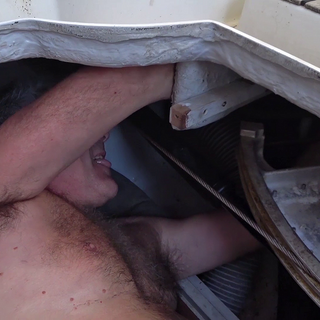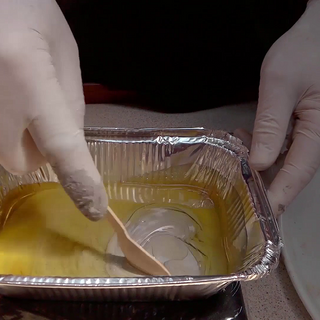It is now a month since the cutlass bearing arrived in Athens, Greece and it has still not been delivered to us here at the boat yard. Ironically the courier company who has the item in their possession is called Speedex. Yeah right.
Strangely other packages have been delivered to us without any delays or problems, one even made it to us all the way from America. I didn't remember ordering anything from the US but as I opened the package Aannsha exclaimed that she knew what it was.
A while back we received an email from a small business called The Lady and The Carpenter and Hilary (The Lady) was enquiring if we'd like to put their hand crafted clothes pegs through the rigours of normal usage in a saltwater environment. Aannsha agreed to the idea and the pegs were mailed to us. Aannsha also bought some new ordinary wooden clothes pegs from the local supermarket and she will conduct a side by side comparison of both types of pegs over the coming months. Hot water
When the great battery meltdown of October 2019 happened we did a lot of looking into any and all possible issues that may have contributed to the demise of batteries that were only 15 months old. One of the things that needed testing was the smart controller that utilises our excess solar panel produced electricity to heat our water via a 12 volt element. We disconnected the controller and at the request of Christopher, the owner of Green Yachting, we mailed it off to the guy who manufactured them in Croatia.
Time passed and several weeks later we received an email stating that the controller had been tested and it was working exactly to its specifications. The controller was then mailed from Croatia to France where Christopher lives. It would be several months before Christopher returned to France as he was enjoying a summer season sailing in the Mediterranean, so returning the controller to us would take some time.
Eventually the smart controller arrived back here at the boat yard and then sat on the nav station desktop waiting for me to get around to the job of reinstalling it. The job would require releasing the hot water tank from its position at the back of a very small locker and that would involve a lot of blood, sweat and swearing from me, so it was a job I was in no hurry to tackle. Eventually I could delay no longer and we readied the cameras and began removing everything from the locker including the internal wooden side panels which gave me access to the 30 litre (8 gallon) water tank.
There's no option to dump the water out of the tank and overboard so I had no choice but to manoeuvre the heavy tank (40 kilos - 88 lbs) in a confined space while it was still full of water. It was a right royal pain in the bum. Eventually I got the tank into a position where I could access the hex shaped top of the heating element and begin the process of removing it.
This time the job was made much easier as we were now in possession of our own 55mm (2.2 inch) box spanner and a super sturdy steel tommy bar (thanks Shelley & Ian). It also required a bit of persuasion with a heavy lump hammer, but we got the element out and I began the process of digging out the temperature sensor which I'd previously sealed into the center of the element with Sikaflex as per the installation instructions. That didn't go well and all I succeeded in doing was to poke the sensor deeper into the tube to the point where it became totally unreachable. Bugger.
Then I noticed that the four ceramic isolators, where the positive and negative electric cables connect, had cracks in them and pieces were flaking off. Even if I had succeeded in removing the temperature sensor I wouldn't have been comfortable in hooking the element back up to our electrical system. So I made the decision to reinstall the original 220 volt heating element and get in touch with Christopher to organise a replacement 12 volt element for installation at some point in the future.
Creaking and groaning
With the hot water tank job completed it was time to move onto another job that can only be done with the same locker empty and the wooden sides removed.
When sailing there is a lot of force put onto the rudder as A B Sea moves through the waves and over time it causes the 8 nuts and bolts that hold the rudder stock quadrant in place to slightly loosen and this causes some creaking and groaning sounds. It's not dangerous, just annoying and it takes about 10 minutes of boat yoga to re-tighten the nuts and bolts.
Next winter when the job needs doing again I'll get some new nylon insert lock nuts and install them using some loctite liquid too.
First time for everything
Many months ago when we had the hire car for a week and we were in Chalkis we bought several items from the marine chandler and one of those was a tin of epoxy primer. The epoxy is a two component liquid and this particular one required a mixing ratio of 7 : 3.
Using the kitchen scales I eked out 210 grams of component A and 90 grams of component B mixed it all together in an aluminium takeaway container and slapped it onto the exposed sections of the keel with a paintbrush. The instructions said the mixture had a pot life of 30 minutes but in my experience it lasted just 20 mins and I only just made it getting the last of the keel covered before the mix went too hard to use.
The aluminium tray I crumpled up and threw in the bin and I then attempted to clean up the brush with what solvents we had on board, none of them worked and the brush had be thrown away too.
I've placed the order for our antifoul paint, more epoxy primer, some epoxy filler and I've also ordered epoxy thinner which hopefully will mean I can utilise the paint brush more than once after I apply future coats of epoxy primer to the keel.
Fingers crossed that Speedex finally live up to their name and the cutlass bearing arrives some time soon. Like I've said in previous blogs, it's going to be a mad dash to the finish line.
To watch the video that accompanies this blog click here.



































